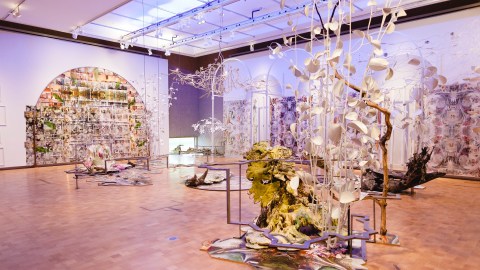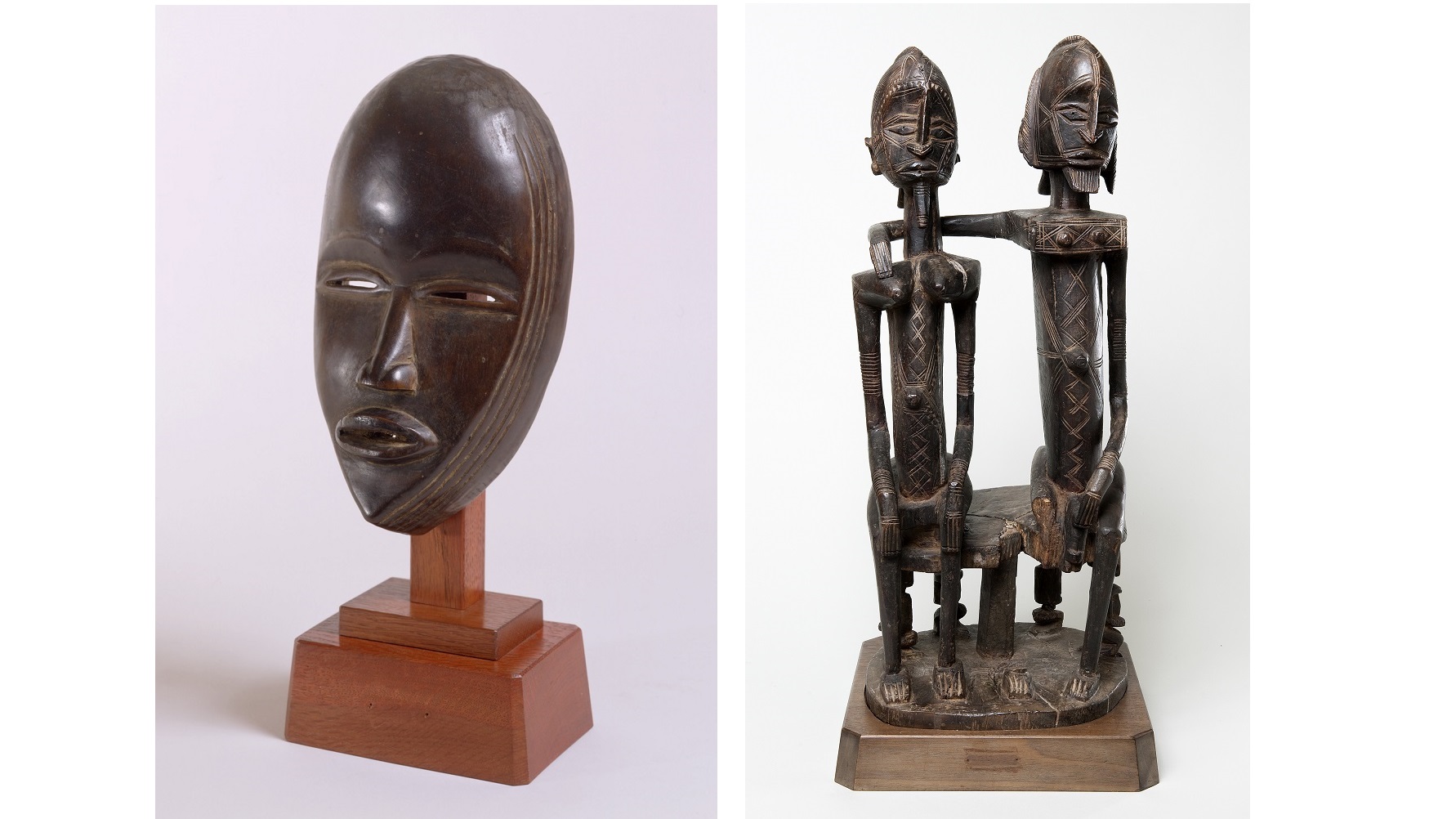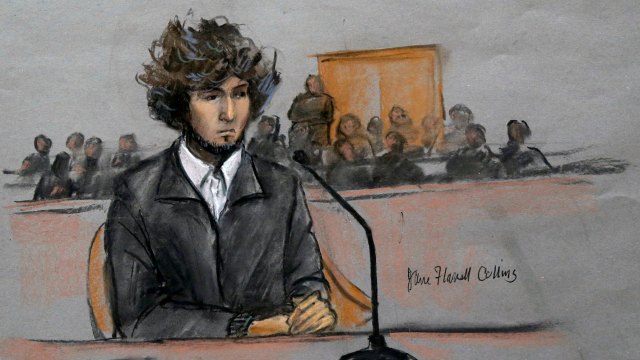Disruptive Innovations: Reordering the Barnes Foundation

Few business buzzphrases draw as much interest (and ire) as “disruptive innovation.” Disrupt or die, the thinking goes. Old orders must make way for new. At the Barnes Foundation, home of Dr. Albert Barnes’ meticulously and idiosyncratically ordered collection of Impressionist and Post-Impressionist masterpieces left just so since his death in 1951, three artistic innovators aim at questioning and challenging Dr. Barnes’ old order. Mark Dion, Judy Pfaff, Fred Wilson: The Order of Things invites three award-winning, contemporary installation artists to disrupt the existing paradigm at the Barnes and assist us in seeing Dr. Barnes and his collection in a whole new way.
Clayton M. Christensen may have introduced “disruptive innovation” in a 1995 article and found a mainstream audience in the 1997 book The Innovator’s Dilemma, but, as Martha Lucy, Barnes Foundation consulting curator and assistant professor of art history at Drexel University in Philadelphia, argues in her catalog essay, Dr. Barnes practiced his own form of disruption way back in the 1920s, long before disrupting was cool. In an era when museums typically arranged their collections along chronological, national, or stylistic (“ism”) lines, Barnes took a radically formalist approach. Where others focused on the content or context of art, Lucy contends, to Barnes “what mattered [instead] was the visible; complete appreciation of the painting could be derived from direct observation.” You didn’t need an advanced degree to understand art, Barnes believed, just your eyes and curiosity.
Barnes, a scientist by trade, borrowed this formalist, purely observational approach from “a generation of influential critics — Roger Fry, Clive Bell, Walter Pach, and Leo Stein — who, during the 1910s and 1920s, brought a rigorous formalist approach to the analysis of art,” Lucy continues. But, “[w]hat set Barnes apart was his embrace of formalism to the extent that it overrode other categories for classification.” Barnes erased history and context to a totalizing extreme. But why?
As Lucy succinctly puts it, for mainstream museums, “Tidy classification was a virtue — the sign of a well-run, professional institution, and indeed of a well-run country.” But “well-run” for whom? Classification usually meant hierarchies, which usually meant repeating and reinforcing typical biases against art by minorities, usually women or African-Americans, often ghettoized by art labels such as “primitive” or “outsider.” In addition to Fry and friends, I’d add John Dewey as a powerful influence on Barnes’ sense of a new order. Dewey introduced a more democratic, pragmatic approach to education by making it more relevant, especially to previously marginalized groups. By prioritizing what’s right under your nose over what happened long ago, Dewey and Barnes leveled the playing field not just for previously underappreciated art forms, but also for people who previously would have found fine art beyond their class or education.
Of course, each new order eventually becomes another old order over time. Dr. Barnes tinkered tirelessly with the arrangement of his collection, always seeking new symmetries and visual echoes between works, sometimes even during the middle of an insomniac night, but that tinkering ended with his death in 1951. Frozen in time, Dr. Barnes’ collection is as famous for its 181 Renoirs, 67 Cezannes, and 59 Matisses as it is infamous for its strict “no loans” and “no rearranging” policies. (The Barnes Foundation can’t even “loan” a work to one of its own special exhibitions right beside the permanent collection.) This new exhibition, another in the series of special exhibitions marking a sea change from the original Merion, Pennsylvania, site to the present Philadelphia site, pays homage to, pokes fun at, reveals new dimensions of, and points to the flaws and strengths of Dr. Barnes’ ordered vision by emphasizing the installation aspect of that vision through three new installations.
In The Incomplete Naturalist,Dion indulges in the “what if” thought experiment of what Dr. Barnes’ collection would look like if he’d gone into natural history instead of art. Pinned to a striking, apple martini green-painted wall, nets, vials, magnifying glasses, and other naturalist equipment allow Dion to explore “the dark side of collecting” in which, as William Wordsworth put it, “We murder to dissect.” Just as a naturalist’s fascination drives her to kill the nature that she loves, Dion argues that Barnes’ obsessive collecting and framing in a new context “kills” an aspect of the art by shearing it away from its original home and forcing it into a new one of his (however well-meaning) choice. There’s a kind of madness in Dion’s symmetrical arrangement (much of which comes from Dion’s own naturalist career), but as a method for disclosing the dark side of Barnes order, it makes perfect sense.
Whereas Dion critiques order with more order, Pfaff challenges stifling order with delightful disorder. In Scene I: The Garden. Enter Mrs. Barnes (detail shown above), Pfaff imagines Laura L. Barnes’ gardens that comprised the Barnes Arboretum (still in Merion) brought “inside” to clash with Dr. Barnes’ sense of order — a green battle of the wills (and, admittedly, sexual stereotypes of male rationality and female intuition). As you walk through Pfaff’s installation, you see the light fixtures hanging from above, the plantings (both real and manufactured) rising from below, as well as the wall decorations closing from without from different angles. A nearby window breaks the claustrophobic clutch the scene momentarily inspires, reminding you of the outside it inspired as well as the outsider female and feminine perspective lost in the Barnesian forest of order.
And just as Pfaff resurrects traces of the lost Laura, Wilson brings back to life human traces overlooked at the Barnes in his simply titled piece, Trace. Rummaging through the offices of the Barnes Foundation for months, Wilson emerged with artifacts ranging from office furniture to discarded gallery benches. Wilson greets you by making the first “trace” the former, now-deceased receptionist’s desk, reproduced to the millimeter with Joan Taylor’s stapler at the ready and the framed print of Cezanne’s Card Players looming behind as well as subtly echoing the everyday desk with extraordinary art. By playing this sympathy card perfectly, Wilson reminds us not only of the synchronicity of the desk and card table, but also of the people behind the foundation whose traces exist in these artifacts and the collection. The Barnes Foundation started with Dr. Barnes, but Wilson reminds us it didn’t end with him.
Of the three installation-based critiques of Dr. Barnes’ sense of order, Wilson’s is the most subtle, but perhaps the deepest. By suggesting that the wavy lines in Van Gogh’s Houses and Figure visually rhyme with the curved coat hangers racked in front of it, Wilson might be laughing at Barnes’ approach and suggesting, to drop another Wordsworthian line, “the mighty world / Of eye, and ear, — both what they half create, / And what perceive.” Maybe all the connections Barnes perceived were simply in his head, which makes them just as legitimate (or questionable) as any in ours. Wilson clearly plays a Duchampian tune in these pseudo-readymades (and outs Barnes as a closet Dadaist), but he strays from Duchamp in restoring some original context to the African objects by softly playing in the background tribal music from their countries of origin. Despite his genuine concern for African-Americans, Dr. Barnes unintentionally robbed his target audience of an appreciation of the people and culture that shaped those African objects ripped from their home by placing them beside the European art that ripped off African art’s “primitiveness” for its own purposes. Wilson’s physical and sound installation reminds us of who did it first.
An additional sound installation by Wilson (that may or may not take place) involves Wilson raiding Dr. Barnes’ personal record collection and playing it in the background of the permanent collection galleries. Listening to Dr. Barnes’ musical tastes (Grand opera? Hot jazz? Delta blues?) would personalize the iconic ensembles in a wholly new way, but it would also reveal them as a product of one person’s taste. Just as jazz isn’t (and shouldn’t be) for everyone, maybe Dr. Barnes’ ensembles aren’t (and shouldn’t be) for everyone, too. To genuflect reverently before any authority defies the very democratic goals of Dr. Barnes original, disruptive vision (via Dewey and others). Mark Dion, Judy Pfaff, Fred Wilson: The Order of Things compels us to question Dr. Barnes’ arrangements not as heresy, but as a true interpretation of his aesthetic and social gospel. The ensembles may never change, but if we can change the way we understand them, then that is change we can all believe in.
[Image:Judy Pfaff, Scene I: The Garden. Enter Mrs. Barnes (detail), 2015. Commissioned by the Barnes Foundation for Mark Dion, Judy Pfaff, Fred Wilson: The Order of Things exhibition. Image © The Barnes Foundation. Photo: Keristin Gaber.]
[Many thanks to the Barnes Foundation for the image above from, a review copy of the catalog to, other press materials for, and an invitation to the press preview for Mark Dion, Judy Pfaff, Fred Wilson: The Order of Things, which runs through August 3, 2015.]
[Please follow me on Twitter (@BobDPictureThis) and Facebook (Art Blog By Bob) for more art news and views.]





